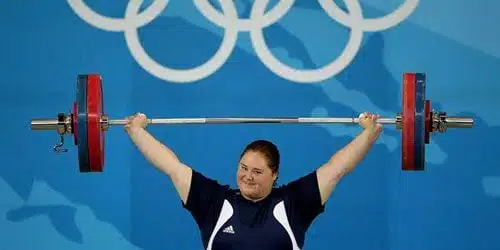
“Nobody can quite put their finger on why they want to be strong.” Cheryl Haworth knows about being strong. As her mother recalls it, when Cheryl was just 13 years old, she pointed to a lifter in the gym and said, “I would really like to try that.”
Cheryl doesn’t press the question of why. Instead, speaking in the documentary Strong!, she focuses on how her strength has evolved, how it shapes her sense of self. “It’s all about confidence,” she adds, “And when that’s shaken, you have to remind yourself why you’re there.” For Cheryl, “there” is on a world stage, where she’s been since she was a teenager. At 15, she was an American national champion (and was for some 11 years following) and, beginning at 17, she made three US Olympic teams, in 2000, 2004, and 2008.
Yes, Cheryl knows quite a bit about being strong, the challenges and costs as well as the rewards. And as Julie Wyman’s film shows her lifting — from multiple angles and shot distances, in light and shadow, in gyms and on starkly attractive movie sets — Cheryl talks about the complicated relationship between strength and weight. “The more mass you have on your body, the more mass you can move, mass moves mass,” Cheryl explains. “It’s just better to be heavier.”
“Better” is a relative term here, like most all the terms in the film, which opens in theaters 18 July and premieres 26 July on Independent Lens. That’s not to say Cheryl’s understanding is imprecise: she knows how to be strong, how to be heavy, and how to move mass. She works hard at what she does, on top of a natural talent. And she inspires respect in her teammates and rivals. It appears that weightlifting, at least as you see it through Cheryl’s eyes, is comprised of a remarkably supportive community. Nicknamed “Fun” by her colleagues, Cheryl uses the camera crew following her around to advocate for fellow lifters. Observing a young man train at the US team’s facility in Colorado, Cheryl takes the opportunity to direct: “Zoom in on that guy,” she says, as the frame cuts from her t Casey Burgener. When he lifts 610 pounds, earning cheers from everyone in the gym — and few watching from outside a window — the camera turns back to Cheryl, who smiles and pops a bit of banana in her mouth as she asserts, “It’s heavy!”
Cheryl’s good humor is tested by injuries and disappointments, inevitable in a sport that’s so “high impact.” Even as she’s hoping to “blow people away” in Beijing, Cheryl suffers a series of injuries, including a torn meniscus in her knee and a torn ligament in her back. And here’s where competition can make you anxious: “When you’re injured,” Cheryl explains, “Witnessing all this progress made by everyone else, you begin to feel like you’re falling behind and you begin to wonder where you fit in.” Here she gets at a key element of how such communities work, how athletes see themselves in relation to one another, how measurements and medals and legacies produce identities.
Strong! explores the complications in this process, embodied by the helpfully charismatic and self-aware Cheryl. She introduces her 1979 Lincoln Continental, Mary Todd Lincoln, a car that weighs about two tons (“I have to fill it up,” she concedes, “Every time I see a gas station”). She also illustrates some of the stories she tells, about building treehouses or playing in the woods as a child. As these drawings come to animated life in the film, they’re an obvious shortcut to her “inner life” (as well as evidence of yet another of Cheryl’s talents).
They’re also a means to show tensions and connections between power and vulnerability. Cheryl articulates these tensions and connections when she describes her sport: “Weightlifting is not simply about heaving weight over your head,” she says. Here the film illustrates in shots that are at once poetic and concrete, Cheryl and two other lifters in an all-white space, lifting in unison, shot in changing shallow focus to suggest ebbs and flows, revealing at once, mighty efforts and delicate mechanics. “It’s much more about timing and flexibility and speed and really understanding how your body works in relation to momentum and inertia and gravity.”
Strong! shows Cheryl’s body works, you come to see as well the complexity of her emotional life, how her body works in culture as well as in competition. “It’s not how I want to be physically,” she says, “But it’s vey good for what I do. So you begin to hate what you do because it’s keeping you trapped somewhere.” The situation is different for men and women, of course, as the film points out: male weightlifters aspire to become bigger and bigger, but “All the women, you’re always trying to get smaller.” Living with such paradoxes can produce confusion and frustration. It can also make you strong.

